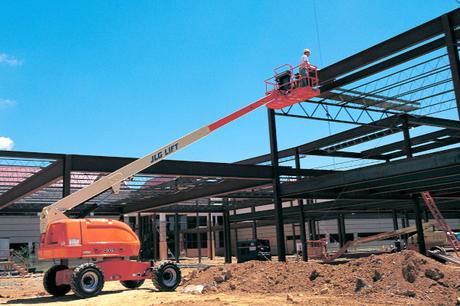 JLG Aerial Lift (Source: JLG.com)
JLG Aerial Lift (Source: JLG.com) Construction job sites often require crew members to access hard to reach areas at elevated heights, both indoors and outoors. Over the years aerial lifts (often referred to as "lifts", "man lifts", "manlifts", or "JLG" or "Genie") have become the favorite cost effective choice for getting the job done.
Aerial lifts were not common on most sites several decades ago. Safety regulations, technology improvements and more advanced machinery solutions have led to the strong adoption of aerial lifts.
Aerial lifts can be grouped into the following categories:
- Boom lifts: Machinery elevates a worker in a bucket or compact work platform and features a grounded base and hydraulic lift system to extend the lift. Boom lifts are capable of reaching out horizontally and vertically from the base.
- Scissor lifts: Machinery has a large flat aerial work platform elevated by interlocking crisscrossed braces. Scissor lifts extend vertically by squeezing together the braces the same way a pair of scissors operates. Suitable for both indoor and outdoor work.
- Vertical lifts: Similar to a scissor lift, a vertical lift elevates vertically. The platform is typically smaller than the average scissor lift, and the vertical height is lower than scissor lifts. Vertical lifts tend to be lighter, more compact and less expensive than scissor lifts. They tend to be better suited for lighter-duty indoor work.
What Is A Boom Lift?
Boom lifts elevate a worker (or workers) in a small bucket or work platform in the air. There are several types of boom lifts, all having different reach capabilities and specifications. Most boom lifts have a wheeled base that is capable of moving over a wide range of ground conditions.
Boom lifts can be divided into two primary categories based on the way the arm operates:
Telescopic boom lift
Have long, straight arms and offer a long reach. The arm is always straight, and the base is typically able to rotate. The arm is more like a telescope where it is straight and can extend out. Telescopic boom lifts are good if you need a far or high reach and your space has plenty of room to access the point.
Some larger telescopic boom lifts have a jib extension near the platform, which provides the boom lift with some articulating movement.
Articulating boom lift
Also known as a "knuckle boom lift" and "cherry picker", the articulating boom lift arm has several joints and is capable of more flexibility when compared to a telescopic boom lift. Articulating boom lifts tend to be better suited for accessing hard to reach areas because they have more ways to maneuver and access the area (telescopic boom lifts can only extend into the area, while articulating boom lifts can approach the area from many different angles).
The arm acts sort of like a finger (has multiple joints). Typically the reach of articulating boom lifts tends to be shorter than telescopic boom lifts, all else equal. Some articulating boom lifts have an extra jib extension that can provide an extra 6 feet of extension in any direction.
What Is A Scissor Lift?
What Is A Veritical Lift?
How To Choose The Right Lift For Your Job
You should consider the following items when deciding the proper lift for your job:
- What height do I require? Scissor lifts are suited for heights 40 feet and below. Anything heigher typically requires a boom lift.
- How many people need to be on the platform at once? Some boom lift platforms can accomodate up to six average size people (varies by weight specifications). Vertical lifts often have space for only one person. Scissor lifts can be more limited relative to boom lifts, depending on the bucket or platform. Just like flying on an airplane, total weight calculation is very important - make sure you check that your total weight will be below the manufacturer recommended maximum weight load.
- What is my budget? Generally speaking the larger and more complex the machine, the more expensive it will be to rent or buy. The large 150+ ft boom lifts cost much more than a simple 30 ft scissor lift.
- What is the terrain? Scissor lifts and vertical lifts are better suited for flat and level ground. Boom lifts provide more flexibility.
- How easy is it to access the space? If you have plenty of space to access the desired point, then you can use any solution. Vertical and scissor lifts must have the immediate opening below the space open. If there is a vertical blockage covering the point you need to access, then a boom lift is likely a better option.
- Do I require mobility? Most boom lifts are able to move on their own, and are capable of driving over bumpy terrain while extended. Many scissor lifts are able to move on their own, but they tend to be more limited.

